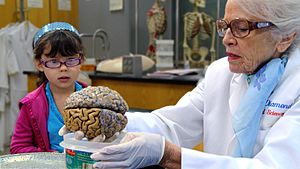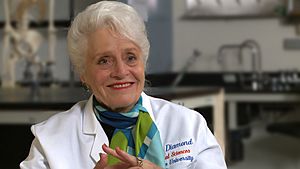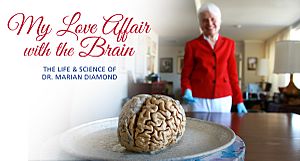Marian Diamond facts for kids
Quick facts for kids
Marian C. Diamond
|
|
|---|---|
| Born |
Marian Cleeves
November 11, 1926 |
| Died | July 25, 2017 (aged 90) |
| Nationality | American |
| Alma mater |
|
| Spouse(s) |
|
| Children |
|
| Awards | The Distinguished Senior Woman Scholar in America awarded by the American Association of University Women |
| Scientific career | |
| Fields | Neuroanatomy, Anatomy, Education |
| Institutions | University of California, Berkeley |
| Thesis | Functional Interrelationships of the Hypothalamus and the Neurohypophysis (1953) |
Marian Cleeves Diamond (November 11, 1926 – July 25, 2017) was an American scientist and teacher. Many people see her as one of the people who started modern neuroscience. She and her team were the first to show that the brain can change and get better with new experiences. This idea is now called neuroplasticity. Her studies on Albert Einstein's brain helped scientists understand more about glial cells in the brain. These are special cells that support brain neurons.
In 2010, her online lectures from the University of California, Berkeley, were very popular. She taught anatomy (the study of the body's structure) at the University of California, Berkeley. Her research also looked at how male and female rat brains are different. She studied the link between positive thinking and a healthy immune system. She also explored the role of women in science.
Contents
About Marian Diamond's Life
Growing Up and School
Marian Cleeves was born in Glendale, California. She was the youngest of six children. Her father was a doctor from England, and her mother taught Latin. Marian grew up in La Crescenta. She went to local schools like La Crescenta grammar school and Glendale High School. Later, she attended Glendale Community College. After that, she went to the University of California, Berkeley. While at Berkeley, she played tennis and earned a special award for athletes called a "letter."
Her Amazing Career
After finishing her first degree in 1948, Marian spent a summer in Norway. Then, she returned to Berkeley for her advanced studies. She was the first female graduate student in the anatomy department. In 1953, she earned her PhD in human anatomy.
Marian loved to teach, and she taught for many years. From 1955 to 1958, she was the first woman science teacher at Cornell University. She taught human biology there. In 1960, she came back to the University of California, Berkeley. She joined a research team as a neuroanatomist. This means she studied the structure of the nervous system.
By 1964, Dr. Diamond found the first proof that the brain can change. This is called plasticity in the cerebral cortex (the outer part of the brain). Her findings opened the door for many more years of brain research. She became a full professor at UC Berkeley.
In 1984, Dr. Diamond and her team got to study parts of Albert Einstein's brain. They were the first to analyze it. Their 1985 paper, "On the Brain of a Scientist: Albert Einstein," caused some debate. But it also made scientists more interested in glial cells.
Family Life
Marian Diamond married Richard Martin Diamond in 1950. They had four children: Catherine, Richard, Jeff, and Ann. They divorced in 1979. Later, in 1982, Marian married Professor Arnold Bernard Scheibel.
Documentary Film About Her
A film called My Love Affair with the Brain: The Life and Science of Dr. Marian Diamond was made in 2017. It shows Dr. Diamond's life as a pioneering woman in science. It also highlights her passion for the human brain and her love of teaching. The filmmakers followed her for five years.
The film often shows Dr. Diamond opening a hat box to reveal a preserved human brain. She would then hold it and share her favorite sayings about the brain. One famous quote is: "The brain is a three pound mass you can hold in your hand that can conceive of a universe a hundred billion light-years across." The film won many awards and was shown on PBS.
Her Big Discoveries About the Brain
Neuroplasticity: The Changing Brain
Dr. Diamond was a pioneer in studying the brain's structure. Her main discoveries changed how we think about the human brain forever. In the early 1960s, she found the first scientific proof of neuroplasticity. Before her work, most scientists believed that your brain was set by your genes and could not change.
Dr. Diamond showed that the brain's structure can change. This happens when you are in different environments. It can happen at any age, from before birth to old age. She did experiments with young rats. She found that rats in a rich environment had a cerebral cortex that was 6% thicker. This was compared to rats in a poor environment. A "rich" environment means one with lots of new things to learn and explore. A "poor" environment has less stimulation. A thicker cortex means better learning. These amazing results, published in 1964, helped start modern neuroscience.
Studying Albert Einstein's Brain
In 1984, Dr. Diamond received parts of Albert Einstein's preserved brain. A pathologist named Thomas Stoltz Harvey had kept Einstein's brain since 1955. Dr. Diamond's team studied two important areas of Einstein's brain. They compared them to the same areas in 11 other male brains.
Dr. Diamond and her team found something special. Einstein had more glial cells per neuron than the average male brains. Glial cells are like support cells for the brain's main cells (neurons). The biggest difference was in a specific area of Einstein's left brain. This area is important for complex thinking. This discovery suggested that glial cells might play a bigger role in intelligence than previously thought.
Dr. Diamond also showed that the brains of males and females are different in structure. She found these differences even without sex hormones. She also discovered that positive thinking can affect your immune system. This means your thoughts can help keep you healthy!
Awards and Honors
Dr. Marian Diamond received many awards for her work, including:
- California Professor of the Year award.
- Alumna of the Year from the California Alumni Association.
- The Distinguished Senior Woman Scholar in America in 1997.
- The Clark Kerr Award for leadership in higher education in 2012.
- The Distinguished Teaching Award from the University of California Berkeley in 1975.
See also
 In Spanish: Marian Diamond (científica) para niños
In Spanish: Marian Diamond (científica) para niños




